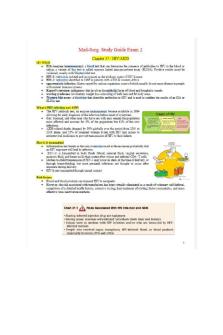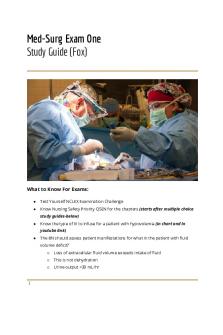Hesi Med Surg Study Guide - Hematemesis Information Nursing Processes PDF

| Title | Hesi Med Surg Study Guide - Hematemesis Information Nursing Processes |
|---|---|
| Author | Rebecca Order |
| Course | Advanced Medical-Surgical Nursing |
| Institution | University of Rhode Island |
| Pages | 13 |
| File Size | 200.1 KB |
| File Type | |
| Total Downloads | 64 |
| Total Views | 144 |
Summary
Hesi notes and study guide ...
Description
HESI I MEDSURG STUDY GUIDE Please use this guide as such, a guide however remember to utilize the basics, the nursing process, ABC’s and prioritize accordingly.
Hematemesis (vomiting blood) – typically upper GI bleed a. What to assess? i. Remember ABC’s (pt having diff breathing?), check vital signs first* ii. Assess stool (blood present? – if so, what color. Dark red = upper GI bleed, usually more serious) iii. Check if they are on iron supplements iv. Worried about hypovolemic shock 1. S/S: restlessness, agitation, inc HR and RR, cool, pale, sweaty
Open vs Close angle glaucoma b. Def: condition characterized by inc intraocular pressure (IOP > 22 mmHg) r/t aqueous fluid being inadequately drained from eye gradual painless vision loss. Generally asymptomatic in early stages (seen in reg eye exam) i. No cure, can be treated pharmacologically and surgically c. Patient teaching i. Develop a teaching plan that includes the following: (p. 131) 1. Careful adherence to eye-drop regimen can prevent blindness 2. Vision already lost cannot be restored 3. Eyes drops are needed for rest of life a. Eye drops used to cause pupillary constriction – mvmt 4. ***Proper eye-drop instillation technique. Obtain a return demonstration. a. Wash hands and external eye b. Tilt head back slightly c. Instill drop into lower lid, s touching the lid c the tip of the dropper d. Release lid, and sponge excess fluid from lid and cheek e. Close eye gentle, and leave closed for 3-5 min f. Apply gentle pressure on inner canthus to decrease systemic absorption g. (Caution: Vision may be blurred for 1-2 hrs post admin and adaption to dark environments difficult r/t pupillary constriction (FALL RISK)) i. Blurring tends to dec c inc use of meds
2
ii. iii. iv. v.
5. Safety measures to prevent injuries a. Remove throw rugs b. Adjust lighting to meet needs 6. Avoid activities that main inc IOP a. Emotional upset b. Exertion: pushing, heavy lifting, shoveling c. Coughing severely or excessive sneezing (Get medical attn before URI worsens) d. Wearing constrictive clothing (tight color or tie, tight belt, or girdle) e. Straining at stool and constipation Increased pressure, asymptomatic, seen at eye exam Can lead to blindness if untreated Eye drops needed for rest of their life Pt teaching – safety measures to prevent injury (remove throw rugs, adequate lighting)
Syndrome of inappropriate anti-diuretic hormone: SIADH o Def: excessive production/release of vasopressin (ADH). Char by dec u/o, inc specific gravity, dec sodium Other manifestation (r/t hyponatremia) Anorexia, N, wt gain, weakness, confusion, irritability, sz/coma Etiology (usually result of underlying condition, aka treat cause) Excess (synthetic vasopressin) DDAVP (Desmopressin) to treat DI, CNS infections, generalized sz’s, surgery to hypothalamus/pituitary o Pt is retaining fluid but so thirsty What else to give them? Hard piece of candy* (want them to salivate)
Hyperthyroidism/hypothyroidism o Signs/symptoms Hyperthyroidism: (p pg. 96, 111) Exophthalmos (bulging eyes) Enlarger thyroid gland Weight loss T3 elevated T4 elevated (>12 mcg/dL) Diarrhea Tachycardia, palpitations, inc BP 2
3
Bruit over thyroid Increased appetite Heat intolerance Diaphoresis, wet or moist skin Nervous, insomnia Hypothyroidism: (p pg. 97, 113) Fatigue Bradycardia Wt gain Constipation Periorbital edema, facial puffiness Cold intolerance Low T3 (8% indicate poor diabetic control – need for adherence to regimen or changes in therapy) Diet, exercise, c Signs of hypoglycemia (p. 121) “Drunk” – too much insulin, too much exercise, not enough glucose H/a Nausea Sweating, cool, clammy Tremors Lethargy 5
6
Hunger Confusion Slurred speech Weakness Blurred vision Tingling around mouth Anxiety, nightmares o S/S of DM II 3P’s (polydipsia, polyuria, polyphagia), hypoglycemia Wt loss, fatigue, frequent infections, blurred vision, impotence
Emphysema and Congestive Heart Failure (CHF) o Subcutaneous emphysema- signs of exam Fine crackles (rice crispy) When air gets released into interstitial tissues by oozes thru walls of bronchioles and alveoli Positive crepitus if you push chest o Priority- ABC
Herpes Zoster o Def: reactivation of latent varicella c inc in frequency among O.A.’s c weakened immune sys Standard/contact precautions o Know how to do thorough assessment of pt c shingles
Unilateral (1 sided), segmental eruptions along affected nerve – show up pose several days discomfort Clustered skin vesicles along peripheral sensory nerves of trunk, thorax, or face (paresthesia – abnormal nerve sensations c touch) Fever/malaise Burning and pain, tenderness, pruritus Usually treated c opioid (like Vicodin May have residual pain after (post therapeutic neuralgia)
Allergies in the hospital – Latex and the cross allergy o Latex – allergy to this, will also have allergy to bananas
Muscular dystrophy
6
7
o Def: X-linked recessive d/o of muscles causing atrophy and weakness – potential prob for breathing (later in disease worry about cardiac muscle degradation) o ABC’s Priority is aspiration o Primary infection – pneumonia
Medication treatments for increased potassium o Kayexulate (Sodium Polystyrene) Binds to K in GI sys and removes in poop (treats hyperkalemia)
Esophageal Varies o Def: abnormal, enlarged veins in lower part of esophagus (connects throat and stomach), since blood flow to liver has been obstructed by scar tissue/clot it seeks other pockets Complication of cirrhosis or liver (may rupture and hemorrhage) o Diet Start c clear liquids, diet as tolerated Fluids restricted (1500 ml/day) Low Na+, K+, fat (may need to restrict protein) HIGH carbohydrate May need lactulose as ammonia detoxicant/stimulant laxative Reminders Must test gag and swallow reflex prior to anything in mouth Progression of foods: clear liquids until tolerated (no N/V), JellO/broth a little later, solids introduced only c active BS (BM and/or flatulence)
Acute Glomerulonephritis o Def: immune complex response to recent b hemolytic strep infection of skin or pharynx; antigen-antibody complexes become trapped in membrane of glomeruli, causing inflammation and dec GFR o Diet – low protein, low sodium, low phosphate, fluid restriction (previous day’s UO + 600ml) Typically small, frequent feedings
Pheocromocytoma o Def: rare, usually noncancerous tumor in center of adrenal glands (above kidney) Mass on adrenal gland (adrenal ca) 7
8
o Recognize symptoms (know what to expect) H/a, diaphoresis L/t persistent episodes of HBP Excessive production of epinephrine and NE, natural catecholamines that raise BP Rapid or forceful heartbeat Tremors Paleness SOB Prioritize intervention- ABCs – airway**
Chronic Kidney disease (CKD) o Progressive, irreversible damage to nephrons in both kidneys o Protein restriction o GFR is used as an indicator of the level of protein consumption o Peritoneal and hemodialysis
BPH symptoms o Urgency o Nocturia o Acute urinary retention o Increased frequency of voiding, c a dec in amt of each voiding o Hesitancy o Terminal dribbling o Dec in size and force of stream o Bladder distention o Recurrent UTI’s
Ferrous sulfate administration (iron) o Used for Iron deficiency anemia Btw meals/empty stomach Combine c OJ or water (NOT milk) o What do we want to check for efficacy of treatment? Rising hemoglobin and hematocrit Hgb: males=14-18, females=12-16 Hct: males=42-52%, females=37-47% o Adverse rxn: Tarry stools (green/black) – OCB
Osteomalacia o Know what it is and the priority for care
8
9
Def: softening of bones in CKD, result of hypocalcemia and hyperphosphatemia – Ca+ starts leaching out of bones, then phosphorus inc to drive Ca+ back into bones, which l/t Osteitis fibrosa (hard, brittle bones/influx of fibrous tissues) Pt c extreme form of bone ca – give all meds at once Breakthrough of pain, severe – managed c scheduled opioid Highest priority c risk for injury (want to ensure adequate Vit D) Want to inc Ca+ levels Aluminum Hydroxide admin c meals to bind to Phos
CVA – o Def: sudden loss of brain function resulting from disruption of blood supply to part of brain o Common signs Expressive aphasia (lack of language abilities), Agraphia (loss of ability to write), alexia (loss of ability to read), dysphasia Weakness, numbness, trouble walking Change in LOC Paresthesia, paralysis Memory loss Vision impairment Bladder and bowel dysfunction Behavioral changes Assessment of pt’s functional abilities, including: Mobility ADLs Elimination Communication Ability to swallow, eat, drink s aspiration o Communication Communication board (Don’t teach sign language)
DTV o Def: inflammation of vein often accompanied by clot formation o Symptoms Edema, functional impairment of extremity Calf tenderness (c gentle palpation) 9
10
Redness Pain, esp c dorsiflexion of foot (relief c warmth to inc venous return and elevate affected leg) o Post op prevention of DVT Leg exercises (keep legs moving), plantar flexion Early ambulation (passive ROM – teach leg exercises q8hr while in bed) Hydration Apply TEDs Teach to avoid pressure htat may obstruct venous flow Don’t bend knees in bed Don’t place pillow beneath knees Avoid crossing legs at knees Heparin admin (activated antithrombin)
Cultural Consideration o Grafting Jewish ppl won’t accept Xenografts (animals)
Trach Care: o Aseptic technique, clean nondisposable inner cannula c H2O2, rinse c sterile saline, 4x4 gauze dressing butterfly folded o Ties Don’t remove old ties before putting new ties in place (only thing anchoring the tube down) o Suctioning – when to suction When the pt needs it (make sure to Hyperoxygenate) Suction when adventitious breath sounds heard Suction when secretions are present at endotracheal tube Suction when gurgling sounds noted o Evaluation of effectiveness of suctioning When lungs are clear Lungs CTA bilaterally Assess pt (cyanosis, use of accessory muscles…) Monitor color of lips, breathing pattern, appearance of secretions during suctions
Colon Cancer 10
11
o Greatest risk factors Ppl >50 y/o Fam hx (1st degree relative) Obesity Polyps Chronic IBD Diets low in fiber, high in fat
Angina o Def: chest discomfort or pain that occurs when myocardial O2 demands exceed supply o When to call 911? After 3 pills/doses of nitroglycerin call 911 (doses = 5m apart)
Patient Education: o Teaching – show demonstration – gold standard Seizures: Ease wife’s concerns – teach pt and fam what to expect when occurring, how long they should last, how to help dec anxiety Def: uncontrolled electrical discharges in brain During: maintain airway, turn pt on side, nothing in mouth, support head
Urination o Signs of UTI Signs of infection, including fever and chills Urinary frequency, urgency, or dysuria Hematuria Pain at the costovertebral angle Elevated serum WBCs (>10,000) o Signs of STI/STD (p. 163) Overlap Itching, weird discharge, sores
Blood Transfusion o Incapability signs (p. 29) What you’ll see if pt is rejecting transfusion
11
12
Chills, fever, low back pain, flushing, tachycardia, hypotension progressing to acute renal failure, shock, and cardiac arrest STOP transfusion, keep IV in (for admin of NS)
Abscess- On the face – check ABC o Have fever o Infection
TB Exposure - PPD o 5mm = normal (for general public) o 10mm = HC workers o 15mm = for ppl who’ve come from areas known to have active TB or live in close quarters of person c active TB (ex. nursing home, prison…)
External fixation o Foot pain d/o o Check pedal pulses (ensure circulation present)
Arterial leg ulcer o Cool extremity, dec/absent pulses, sharp pain that inc c walking and elevation, intermittent claudication (cramping pain) o Pt teaching:
Look for wounds Proper foot care – call podiatrist for nail cutting
Know who’s more acute (prioritize) o Ex. pt that’s actively dying vs pt c sign laceration Going to go to laceration pt 1st
Lightening strike o Priority nursing action = put pt on heart monitor
Signs of MI o Sweating Epigastric pain (3 days) o What EKG shows: ST segment elevation
12
13
Side Notes:
Central Venous Pressure (CVP) norm value: 2-6mmHg
13...
Similar Free PDFs

Med Surg Study guide Notes
- 66 Pages

Med Surg 2 Final Study Guide
- 25 Pages
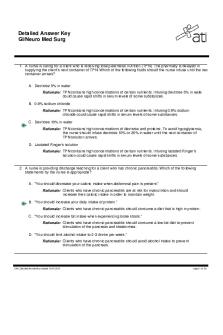
Ati gi med surg - Gi study guide
- 53 Pages
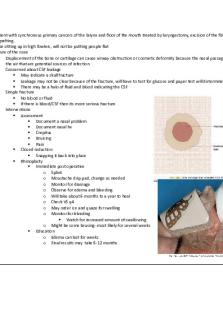
Med Surg II - Exam 2 Study Guide
- 57 Pages

Med surg exam 1 study guide
- 25 Pages
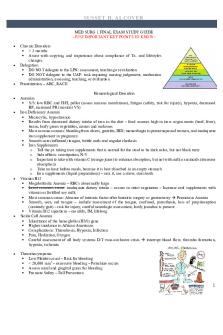
MED SURG 1 Final EXAM Study Guide
- 10 Pages

Med Surg 2 Exam 3 Study Guide
- 22 Pages
Popular Institutions
- Tinajero National High School - Annex
- Politeknik Caltex Riau
- Yokohama City University
- SGT University
- University of Al-Qadisiyah
- Divine Word College of Vigan
- Techniek College Rotterdam
- Universidade de Santiago
- Universiti Teknologi MARA Cawangan Johor Kampus Pasir Gudang
- Poltekkes Kemenkes Yogyakarta
- Baguio City National High School
- Colegio san marcos
- preparatoria uno
- Centro de Bachillerato Tecnológico Industrial y de Servicios No. 107
- Dalian Maritime University
- Quang Trung Secondary School
- Colegio Tecnológico en Informática
- Corporación Regional de Educación Superior
- Grupo CEDVA
- Dar Al Uloom University
- Centro de Estudios Preuniversitarios de la Universidad Nacional de Ingeniería
- 上智大学
- Aakash International School, Nuna Majara
- San Felipe Neri Catholic School
- Kang Chiao International School - New Taipei City
- Misamis Occidental National High School
- Institución Educativa Escuela Normal Juan Ladrilleros
- Kolehiyo ng Pantukan
- Batanes State College
- Instituto Continental
- Sekolah Menengah Kejuruan Kesehatan Kaltara (Tarakan)
- Colegio de La Inmaculada Concepcion - Cebu

